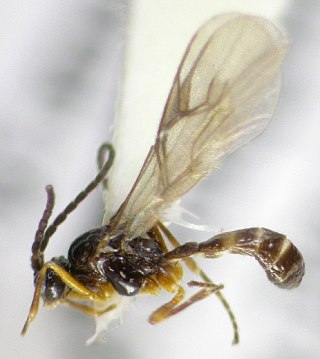
In evolutionary ecology, a parasitoid is an organism that lives in close association with its host at the host's expense, eventually resulting in the death of the host. Parasitoidism is one of six major evolutionary strategies within parasitism, distinguished by the fatal prognosis for the host, which makes the strategy close to predation.

Green lacewings are insects in the large family Chrysopidae of the order Neuroptera. There are about 85 genera and 1,300–2,000 species in this widespread group. Members of the genera Chrysopa and Chrysoperla are very common in North America and Europe; they are very similar and many of their species have been moved from one genus to the other time and again, and in the nonscientific literature assignment to Chrysopa and Chrysoperla can rarely be relied upon. Since they are the most familiar neuropterans to many people, they are often simply called "lacewings". Since most of the diversity of Neuroptera are properly referred to as some sort of "lacewing", common lacewings is preferable.

The Braconidae are a family of parasitoid wasps. After the closely related Ichneumonidae, braconids make up the second-largest family in the order Hymenoptera, with about 17,000 recognized species and many thousands more undescribed. One analysis estimated a total between 30,000 and 50,000, and another provided a narrower estimate between 42,000 and 43,000 species.

Parasitoid wasps are a large group of hymenopteran superfamilies, with all but the wood wasps (Orussoidea) being in the wasp-waisted Apocrita. As parasitoids, they lay their eggs on or in the bodies of other arthropods, sooner or later causing the death of these hosts. Different species specialise in hosts from different insect orders, most often Lepidoptera, though some select beetles, flies, or bugs; the spider wasps (Pompilidae) exclusively attack spiders.

The Aphidiinae are a subfamily of tiny parasitoid wasps that use aphids as their hosts. Several species have been used in biological control programs of various aphids.

A wasp is any insect of the narrow-waisted suborder Apocrita of the order Hymenoptera which is neither a bee nor an ant; this excludes the broad-waisted sawflies (Symphyta), which look somewhat like wasps, but are in a separate suborder. The wasps do not constitute a clade, a complete natural group with a single ancestor, as bees and ants are deeply nested within the wasps, having evolved from wasp ancestors. Wasps that are members of the clade Aculeata can sting their prey.

Microgastrinae is a subfamily of braconid wasps, encompassing almost 3,000 described species, with an estimated 30,000–50,000 total species. This makes it one of the richest subfamilies with the most species of parasitoid wasps.

Cotesia glomerata, the white butterfly parasite, is a small parasitoid wasp belonging to family Braconidae. It was described by Carl Linnaeus in his 1758 publication 10th edition of Systema Naturae.

Apanteles is a very large genus of braconid wasps, containing more than 600 described species found worldwide. There are no native species in New Zealand, and none have been recorded in the high arctic.

Dolichogenidea is a genus of parasitoid wasps in the family Braconidae. There are more than 360 described species in Dolichogenidea, found throughout the world.

Meteorus rubens is a species of parasitoid wasp in the family Braconidae which attacks significant crop pests including the black cutworm, Agrotis ipsilon. The wasps have been shown to be easily collected through the use of traps baited with mustard oils. They have been shown to carry Rioviridae RNA viruses, one of only a few parasitoids to carry them.
Aleiodes gaga is a species of parasitoid wasp belonging to the family Braconidae. It was first described by Donald Quicke and Buntika Butcher in 2012 after a single individual was discovered in the Chae Son National Park in Thailand. The species is named after Lady Gaga. This species is one of 179 species identified by the first "turbo-taxonomic" search of DNA barcoding of cytochrome oxidase I (COI).

Spathius is a genus of doryctine wasps. The larvae of this genus of wasps feed on beetle larvae. They act as biological controllers of the certain pest beetles, such as Hylurgopinus rufipes and the emerald ash borer.

Chrysopophthorus is a genus of braconid wasps in the family Braconidae. There are about eight described species in Chrysopophthorus.

Adeliini is a tribe of braconid wasps within the subfamily Cheloninae. Until 2016, Adeliini was classified as a separate subfamily, the Adeliinae. They are small, stout-bodied braconids that parasitize the larvae of leaf-mining moths. Despite being widespread, they tend to be rare in entomological collections.
Syntretus is a genus of parasitoid wasps. Most parasitize adult hymenopterans, though one species parasitizes adult Drosophila fruit flies.

Diolcogaster is a genus of parasitoid wasps within the subfamily Microgastrinae of the family Braconidae. The genus is poorly studied, likely with multiple undescribed species. The type species is Diolcogaster melligaster(Provancher, 1886), formerly Microgaster melligaster. Species in this genus parasitize lepidopterans and are geographically widespread. There are more than 140 described species in Diolcogaster found throughout the world.

Biosteres is a genus of wasps belonging to the family Braconidae.

Aphidius is a genus of insects of the family Braconidae.

Microplitis mandibularis is a gregarious parasitoid wasp in the family Braconidae (Hymenoptera).

















